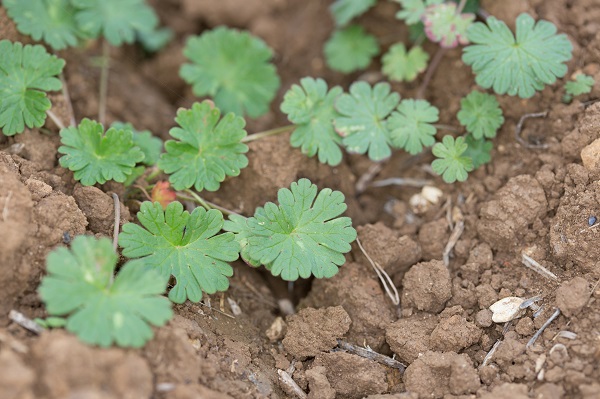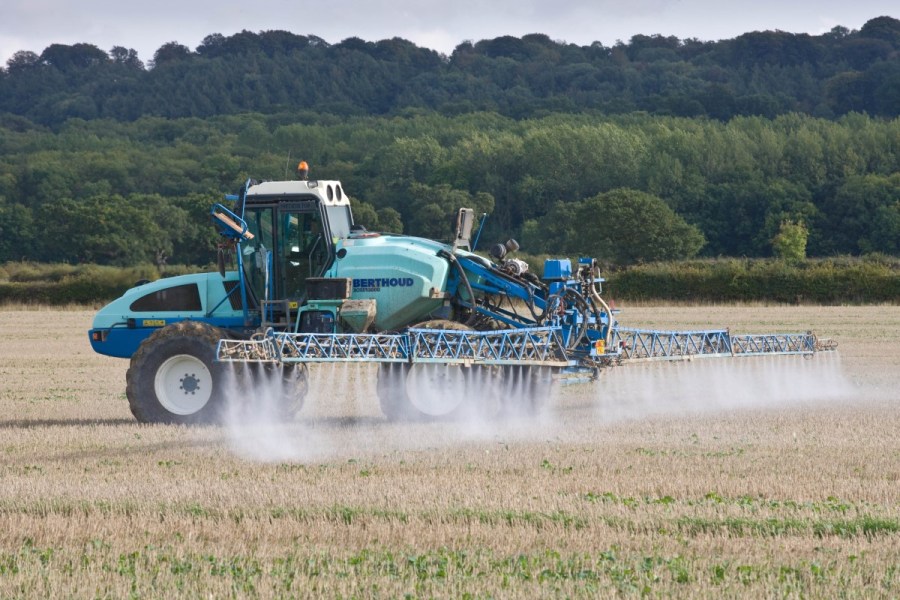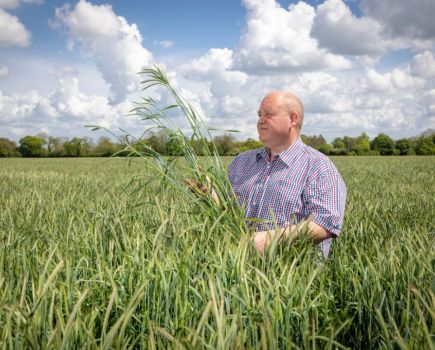Research has shown that a new range of products can boost the efficacy of age-old herbicide, glyphosate, thanks to a novel dual-salt formulation. CPM takes a look at the findings and what practical benefits switching to 540g dual-salt technology could bring to growers.
It’s really important not to skimp on the details when it comes to crop protection products and use.
By Charlotte Cunningham
Glyphosate has been the long-standing best friend of arable growers for many years – providing sound weed control against some of the most yield-robbing threats. While growers have been largely satisfied by the level of control it provides, there’s a new kid on the block that looks like it could shake things up in terms of weed management.
Traditional glyphosate is formulated as one of a range of salts – Potassium (K), Isopropyl amine (IPA) or in some cases, ammonium (NH4 ). This provides the carrier for the active ingredient to travel within the plant to where it does its job.

Dual-salt technology has shown superior control in broadleaf weeds, such as cranesbill.
International crop solution firm, Nufarm, has taken the single-salt principle and created a patented range of products containing two or more salts with the intention of increasing both the efficacy and reliability of glyphosate. “We are always looking to develop novel mixtures and products to increase the availability of tools for farmers,” says Dick Dyason, Nufarm.
“While the acid is what does the business in glyphosate formulations, for it to work, it has to be presented in a salt form – hence the development of dual-salt technology, patented by Nufarm as ‘Advanced Salt Technology’ (AST). We are the only company that currently offers this kind of product,” he adds.
So what exactly is dual-salt glyphosate and how does it work? As it says on the tin, it’s a formulation comprising two salts – as opposed to the singular formulation seen in traditional glyphosate.
The benefit of this technology is a biological synergism between the two salts, delivering superior weed control over a single salt, explains Dick. “The interaction of the two substances produces a combined effect greater than the sum of their separate effects. This synergistic effect has been proven via the Colby formula.”
The Colby formula is a scientific analysis used to measure herbicide interaction, based on a ‘presumed’ level of control from mixing two or more herbicides together. The equation then looks at the actual effect of the mixture (expressed as a percentage of control) compared with the ‘presumed’ value. If this is greater than the presumed figure, then synergism is present.
This testing involved using single and dual-salt products at low levels and weighing the plants before and after to observe uptake. In practice, the presence of synergism in dual-salt technology translates to proven greater activity, increased reliability and a superior kill speed, explains Dick.
One of the most popular products available is Rattler, an SL containing 540g/l of glyphosate (acid equivalent) as 400.8g/l of isopropylamine salt and 299g/l of potassium salt plus the addition of a Terwet surfactant.
It’s available for use on a range of crops including barley, wheat, combinable peas, oats, linseed and mustard and can be used pre-drilling, pre- and post-harvest or pre-emergence. The product is available now across the UK and has proven to be extremely effective in trials.
The firm put the dual-salt technology in a 2011 trial with Kyleo (glyphosate+ 2,4D) with NIAB to check out how long the drilling intervals in oilseed rape stubble should be to ensure the following crop emerges unharmed, but weed control of the Rattler was assessed as well. The results, unsurprisingly, highlighted superior kill speed in the dual-salt products. “The AST has shown particular benefits over single-salt glyphosate in the control of broadleaf weeds such as cranesbill in mixed weed situations in stubbles,” adds Dick.
As well as improving control of arable weeds, Nufarm’s AST has also shown improved uptake and translocation of glyphosate in perennial ryegrass. “Dual-salt products outperformed IPA salts in terms of leaf uptake at two hours and 24 hours as well as translocation to the roots.”
However, even with the best products in the world, there are external factors which can affect the efficacy of glyphosate such as humidity and temperature. “Humidity is the main determinant in penetration of the cuticular layer – as well as cuticular thickness, wax and hair levels,” explains Dick. “At high humidity, glyphosate uptake is nearly 10 times faster than at low humidity. IPA salts have shown the best uptake in high humidity conditions, whereas at lower levels of humidity, potassium salt glyphosate comes out on top.”
With this in mind, Rattler combines the two for all-round optimum intake. “For the best results from glyphosate, apply when humidity is at its greatest – provided rainfall is not expected.”
Temperature can have similar effects on uptake. “Trials have shown that the uptake of glyphosate is 2.5 times faster at 25°C than at 10°C,” he adds. “What’s more, the uptake of K salt is faster than IPA salt at lower temperatures but IPA salt uptake is faster than K salt at higher temperatures. To cover growers in all eventualities, Rattler is optimised with both K and IPA salts.”
Turning thoughts to public perception, recent press coverage has put glyphosate firmly in the media spotlight. With strong criticism of the product, there’s pressure on farmers to demonstrate high levels of stewardship – including the launch of the #glyphosateissafe campaign. So could this new formulation help to achieve that goal? “While the dual-salt technology won’t reduce application rates, it could potentially reduce the number of applications being carried out, due to the improved reliability and control,” notes Daniel Macdonald, Nufarm.
Glyphosate efficacy has also faced scrutiny recently. Research released by Rothamsted and ADAS last year showed that some UK populations of sterile brome had reduced susceptibility to glyphosate and were in the process of evolving resistance. To reduce the risk of resistance, the Weed Resistance Action Group (WRAG) advises growers to maintain dose rate but reduce number of applications.
While there is no denying the facts, Daniel reckons that reduced efficacy could be due to application technique rather than resistance issues. “My personal views are that a lot of sensitivity fears are actually just down to poor application. It’s really important not to skimp on the details when it comes to crop protection products and use. Particularly with grassweeds, it’s much harder to hit a single blade of grass than a broadleaf weed, so that’s an area to really consider.”
Emphasis on responsible use in Warwicks
Nufarm’s technology has not only impressed growers but has also attained agronomist approval. Sam Clarke has been working as an independent agronomist in Warwicks for the past seven years and made the switch from traditional 360g glyphosate to dual-salt formulations a few years ago. “There’s been a big change in the formulation of 360g glyphosate over quite some time, and I began to get concerned over the efficacy levels – it’s often referred to as the ‘cooking oil’ of glyphosate,” he says.
“I also had concerns about resistance and was looking for a way to refine the use of glyphosate. Opting for dual-salt technology is a responsible use of an active we heavily rely on.”
Sam switched to using a Nufarm dual-salt product – Snapper – and has been left highly impressed with its delivery in the field. “If I’m spraying something with glyphosate, I want to make sure everything is killed. From what I’ve seen, the dual-salt products work very well to achieve this and I’ve anecdotally heard reports of faster kill speed.”
The higher concentration is also advantageous, he adds. “A more concentrated formula means less cans and spray operators really seem to prefer it.”
One area to watch for is when it comes to putting together a tank-mix, explains Sam. “In terms of the tank-mixing sequence, in hard water areas it’s crucial to put in a water conditioner before the active goes in to prevent it from locking up.”
With increased performance comes an additional cost. However, the evident improvement to weed control outweighs any increase in financial outlay, he adds. “There’s the potential to curb adjuvant use – and potentially cost – as the products are pre-formulated so you don’t need to add huge volumes (of adjuvants).”
Despite the potentially higher cost, Sam believes dual-salt products are definitely an option worth considering. “The beauty of being independent – and one of the main reasons agronomists go it alone – is because you get to make your own decisions about what is a good or bad product.
“I’m a self-confessed sceptic when it comes to products, but there’s no doubt that dual-salt technology can provide some very credible benefits to arable growers.”
Dual-salt benefits
- Greater activity than single salts
- Increased reliability
- Proven superior kill speed
- Usability in a range of weather conditions
- Efficacy can be improved further by adding water conditioners in hard water areas
- Rainfastness at least matches premium brands
- More environmentally friendly due to a high strength formulation meaning 33% less packaging is used
Research Briefing
To help growers get the best out of technology used in the field, manufacturers continue to invest in R&D at every level, from the lab to extensive field trials. CPM Research Briefings provide not only the findings of recent research, but also an insight into the technology, to ensure a full understanding of how to optimise its use.




